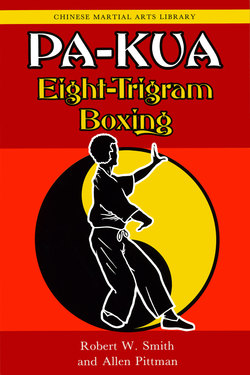Читать книгу Pa-kua - Robert W. Smith - Страница 7
На сайте Литреса книга снята с продажи.
ОглавлениеPreface
We wrote this book believing that there are many people who are interested in the Chinese internal martial art of Pa-kua (pronounced “ba-gwa”) as it was traditionally taught on the mainland.* Such people understand that this art is a meditative form of health and body management from which self defense spills over, rather than an aggressive combat form, of which the world already has too many. As a system of self defense, however, it is harshly effective.
Besides training for several years in Taiwan under the Pa-kua masters Hung I-hsiang and his brother Hung 1-mien, Mr. Smith was also fortunate enough to be allowed to study under Wang Shu-chin, Kuo Feng-ch’ih, Yuan Tao, and other masters. His training path is very clearly outlined in his Chinese Boxing: Masters and Methods (Tokyo, 1974) and other books. Some twenty years later, Mr. Pittman, one of Mr. Smith’s senior students, went to Taiwan seeking the old masters, but found that many had died. In Taipei, however, he came across a still hardy Hung I-mien, who invited him to share his home as a live-in student. After absorbing Hung’s Hsing-i and Pa-kua, he traveled south to Taichung to practice with the sons of the late Ch’en P’an-ling—Yuan-ch’ao and Yun-ch’ing—and the senior students of the late Wang Shu-chin.
From these experiences, the basic forms of these two master teachers as taught to the authors were assimilated and consolidated. This is the first time that they have been taught to the West in such minute detail. We hope that Western students will benefit from this exposition of teachings that were once only passed on to initiates deemed worthy of learning the styles and being entrusted with their transmission.
The Pa-kua forms given in this book are essentially those of Wang Shu-chin as elaborated in his Pa-kua lien-huan chang [Pa-kua Linked Palm] (Taipei, 1978; privately published). Also used as sources were the two books considered to be the best ever written on the art: Sun Lu-tang’s classic Pa-kua ch’uan hsueh [A Study of Pa-kua Boxing] (Peking, 1916) and Huang Po-nien’s Lung-hsing pa-kua chang [Dragon-Style Pa-kua Palm] (Shanghai, 1936). These are the orthodox, traditional methods long practiced on the mainland and in Taiwan—the authentic forms from which most other versions derive. They are being published here so that students can learn the real forms as opposed to the Americanized offshoots. These forms are designed to refine your nature, reform your temperament, and return you to your original self.
But it is a rash reader who thinks that by simply buying this book he or she will mysteriously be enabled to absorb the teachings it contains. To learn any of the three internal arts—Tai-chi, Hsing-i, or Pa-kua—requires commitment, not mere involvement. Being involved or committed is like ham and eggs: the chicken is involved but the pig is committed! This is not a coffee-table book—it should be sweat over and on. We have labored over its presentation, carefully blending the pictorial with the textual, so that the student can study correctly. But our efforts are in vain if the student does not practice. He or she must practice assiduously for a long time if progress is to come. Confucius once said that if he gave a student one corner of a handkerchief, it was up to the student to find the other three corners. This book is but one corner; your practice will help you find the other three.
Footnote
*In this book, Chinese terms are transliterated with the Wade-Giles system, except where the word is already widely used with a different spelling, as, for instance, “Peking, “Nanking,” etc.
